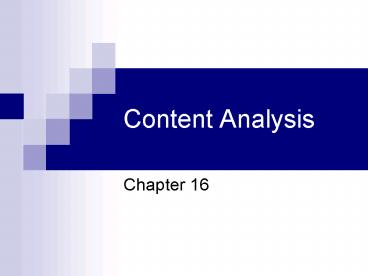Content Analysis - PowerPoint PPT Presentation
1 / 20
Title: Content Analysis
1
Content Analysis
- Chapter 16
2
What is Content Analysis?
- Approach to analysis of documents and texts,
including visual images, aural and virtual text - may be quantitative or qualitative
3
Quantitative Content Analysis
- Quantifies content in terms of predetermined
categories - Attempts to be systematic and reliable
- Rules for how to assign unstructured material to
pre-coded categories
4
Research Questions (Quantitative)
- Must be clearly specified before analysis
- Decide which dimensions of texts to quantify
- e.g., news coverage of an issue
- who, what, how much, where, when and why?
- how many different views represented?
- what is selected for inclusion?
- omissions what is not reported?
5
Sampling Media
- Which types of text?
- printed or visual data? documents? mass media?
- If mass media, which kind?
- TV, radio, newspapers, magazines, or more than
one type? - For each type of text, which examples?
- e.g., tabloid or broadsheet newspapers
6
Sampling Dates
- May be determined by event analysis
- May be historical analysis of older texts
- May be ongoing, general phenomenon
- when to start and stop analyzing?
- Probability sampling where possible
7
What is to be Counted?
- Significant actors
- protagonists and alternative voices
- Words
- frequency of emotive words
- connotations and styles of discourse
- Subjects and themes
- Dispositions
- values and ideology
8
Coding Schedule
- Form onto which coded data will be entered
- Often a tabular form
- Each column represents a dimension to be analyzed
- Each row represents a unit of analysis (item of
text) - Codes are written into blank cells in table
9
Coding Manual
- Set of instructions for coders lists all possible
categories for each dimension and shows which
codes/numbers refer to which category - Provides guidance on how to decide on a code and
what to do if more than one code applies
10
Practice
- Media Tobacco ads from the 1960s
- Research question What ideals, desires and
fears do tobacco companies exploit to sell
cigarettes?
11
Content Analysis
- Manifest content
- taste
- value for money
- superior produce
- superior packaging
- Latent content
- achieve status
- become sexier
- become happier
- become more popular
- become more manly or womanly
12
Coding Schedule Columns
- Lead
- sex, age, quality, lights own, lights companion
- Companion
- sex, age, quality, lights own, lights lead
- Relationship
- romance, married, friends, etc.
13
- Setting
- domestic, rural, urban public space, recreation,
work, nature, car, boat - Manifest content
- taste, value for money
14
Coding Manual Qualities of Lead Character
- smart
- strong/tough
- sexy
- independent/free
- popular/ belonging
- sensual
- prudent/ thrifty
- good parent
- wealthy
- attractive/ alluring
- talented
- heroic
- likeable/ average
- successful
- respectable
- generous
15
Potential Pitfalls
- Ensure that coding scheme has
- discrete dimensions
- mutually exclusive categories
- exhaustive categories
- clear instructions to coders
- specified unit of analysis
- inter-coder and intra-coder reliability
16
Advantages of Content Analysis
- Transparent, replicable method
- Counting involves minimal interpretation
- Allows for longitudinal analysis
- Relatively unobtrusive - no reactive effects
- Flexible - can be applied to various texts
- Provides information about populations that are
difficult to access directly
17
Disadvantages of Content Analysis
- Only as good as the quality of the documents
- Coding manuals have to be interpreted
- Variant interpretations of latent content
- Descriptive rather than explanatory
- no answers to why questions
- Atheoretical?
18
Qualitative Content Analysis
- Inductive method
- Search for underlying themes in documents or text
- No reliance on predetermined categories
- Themes are expanded and refined in the process of
analysis - Selected material is presented to illustrate
themes
19
Traditions of Qualitative Content Analysis
- Semiotics
- study of signs/symbols in everyday life
- polysemy many possible interpretations of
ordinary signs - Hermeneutics
- study of texts from perspective of its author
- interpreted within historical and cultural context
20
- Conversation analysis
- originated in ethnomethodology
- study of taken-for-granted rules that structure
social interaction - Discourse analysis
- more than the study of talk and language
- concerned with the ways language constitutes
social reality and its effects































